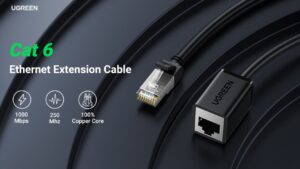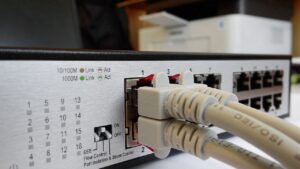Cat 5 Ethernet, commonly known as Category 5, is a standard network cable used for high-speed data transmission. It’s widely utilized in Dubai and across the UAE to connect computers, devices, and networks, facilitating seamless communication and internet connectivity. In the region, its popularity among both residential and business users is driven by its reliability and affordability, making it the top choice.
I. Are Ethernet Cables The Same

1. Ethernet Cable Types:
- Cat 5e: Standard for most home networks.
- Cat 6: Offers faster speeds and less interference.
- Cat 6a: Supports 10Gbps over longer distances.
- Cat 7: Enhanced shielding for reduced crosstalk.
- Cat 8: High-speed data transfer for enterprise use.
2. Length Matters:
- Choose the right cable length for your setup to avoid signal loss.
- Common lengths: 3, 5, 10, and 25 feet.
3. Use Cases:
- Cat 5e and Cat 6: Home networks, gaming, and basic office use.
- Cat 6a and Cat 7: Demanding applications like 4K streaming and server setups.
- Cat 8:High-speed connections power the backbone of enterprise data centers.
4. Consider Connectors:
- RJ45 connectors are standard for Ethernet cables.
- Check for gold-plated connectors for better conductivity.
5. Quality Matters:
- Ensure reliability and top-notch performance by investing in well-established and trusted brands.
- Look for cables certified by organizations like TIA or EIA.
- Remember to choose the Ethernet cable that suits your specific needs, from basic internet browsing to high-performance networking.
II. Cat 5 Ethernet Cable

- Speed and Performance: Cat 5 Ethernet cables are ideal for basic internet browsing and light file sharing, as they offer support for data transfer speeds of up to 100 Mbps.
- Compatibility: They are compatible with older devices and networking equipment, but may not fully utilize the capabilities of modern high-speed networks.
- Distance Limitations: Cat 5 Ethernet cables have a maximum effective length of 100 meters (about 328 feet), so they’re not ideal for long-distance connections.
- Twisted Pair Design: Cat 5 Ethernet cables use twisted pairs of copper wires to reduce interference, providing reliable connections for shorter distances.
- Affordability: With their cost-effective pricing and easy accessibility, Cat 5 Ethernet cables are a budget-friendly option for setting up basic home networks.
- Obsolete Standard: Cat 5 has largely been replaced by newer standards like Cat 5e and Cat 6, which offer better performance and support higher speeds.
- Not Suitable for Gigabit Ethernet: Cat 5 cables may not offer adequate bandwidth and are not advisable for Gigabit Ethernet (1,000 Mbps) connections.
- Limited Future-Proofing: Due to their lower data capacity, Cat 5 cables may become obsolete as network technology continues to advance.
- DIY-Friendly: Easy to install and terminate, making them a popular choice for DIY network setups.
- Consider an Upgrade: For faster speeds and future-proofing, consider Cat 5e, Cat 6, or higher-rated cables for your networking needs.
III. Cat 5 Ethernet Cable Speed

- Cat 5 Ethernet cables can accommodate speeds of up to 1000 Mbps.
- It’s suitable for most home networks and basic office setups.
- Cat 5e and Cat 6 offer faster speeds for demanding applications.
- Consider upgrading if you need higher data rates.
IV. Cat5 vs Cat6

1. Cat5:
- Older standard.
- Supports up to 1000 Mbps (1 Gbps).
- Limited shielding.
- Maximum length of 100 meters.
- Cost-effective for basic networking.
2. Cat6:
- Improved standard.
- Supports up to 10,000 Mbps (10 Gbps).
- Better shielding, reduced crosstalk.
- Maximum length of 55 meters for 10 Gbps.
- Ideal for high-speed data transfer and future-proofing.
A. What is Cat 5 Ethernet?
- Definition: Utilized in the realm of networking, Category 5 (Cat 5) Ethernet cables belong to the category of twisted-pair cables.
- Speed: Supports speeds up to 1000 Mbps (1 Gbps) over short distances.
- Usage: Commonly used for home and small office networks.
- Connectors: Utilizes RJ-45 connectors.
- Limitations: Limited for longer distances and high-speed data transfer compared to newer Ethernet standards like Cat 6 and Cat 7.
B. What is Cat7 Ethernet?
- Speedy Performance: It can send and receive data at a whopping 10 gigabits per second (Gbps). That’s like having a superfast highway for your internet traffic.
- Long-Range: Cat7 Ethernet can maintain its high-speed performance over a distance of up to 100 meters. Hence, it’s an excellent choice for larger offices or expansive homes.
- No Interference: It’s excellent at blocking interference from other electronic devices. Picture engaging in a peaceful conversation within a serene room, as opposed to a noisy and bustling environment. Cat7 Ethernet ensures your data gets through without disturbance.
- Perfect for Gamers: If you’re a gamer, Cat7 Ethernet is your best friend. It reduces lag and makes sure your moves in the game are lightning-fast.
- Crystal Clear 4K Streaming: When you’re watching 4K videos, Cat7 Ethernet ensures you get the highest quality without buffering. It’s like having a cinema experience at home.
C. Is Cat 5 Good For Ethernet?
Yes, 5 Ethernet is still really great for Ethernet, particularly for home and private company organizations. It can uphold speeds up to 100 Mbps, which is adequate for most web associations, web-based videos, and other web-based exercises. Feline 5 Ethernet links are likewise generally inexpensive and simple to install.









